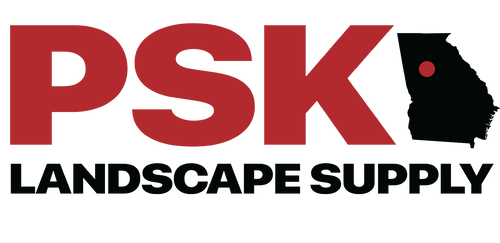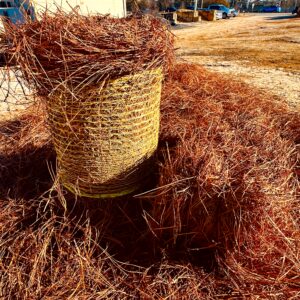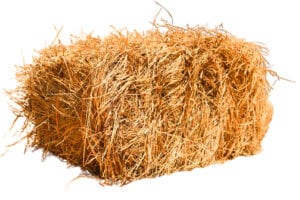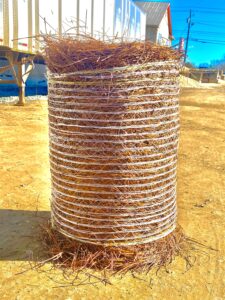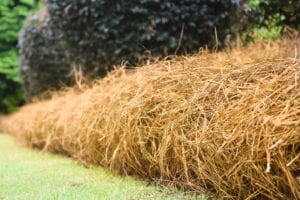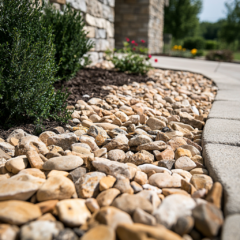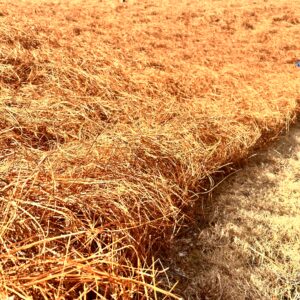What is The Difference Between A Bale and a Roll of Pine Straw?
A bale of pine straw coverage is ideal for small to medium landscaping projects, with each tightly bound, square or rectangular block of compressed pine needles covering about 40-50 square feet. On the other hand, straw rolls, which are larger and mechanically processed bundles, contain up to 2.25 times the amount of a pine straw bale coverage and can spread over 100-120 square feet. Rolls are more efficient for larger areas, offering ease of application and less material loss. The choice between bales and rolls depends on your project’s scale, budget, and preference.
Understanding Pine Straw
Before we drill down into the specifics of bales and rolls, let’s first establish what pine straw is and why it is essential for landscaping. Pine straw vs pine needles, a natural, biodegradable product derived from the fallen needles of pine trees, serves as an excellent landscaping material due to its aesthetics, soil enhancement capabilities, and erosion control properties.
Applications of Pine Straw
Pine straw has found its place in a wide array of applications, most commonly used as a ground cover in landscaping, bestowing a natural aesthetic to the area. It’s also employed in flower beds, offering a protective layer that aids in moisture retention and weed suppression, highlighting the benefits of spreading pine straw for an improved appearance.
Apart from these uses, pine straw is a potent tool for erosion control, one of its key benefits. Its structure and durability make it an effective barrier against soil displacement, thus preserving the integrity of your land. Regardless of whether you’re using pine straw bales or rolls, these applications remain consistent.
Pine Straw Bales: A Closer Look
Traditionally, pine straw has been offered in the form of square bales. These square or rectangular blocks of pine straw are manually raked, placed in a box, and then tied together. A standard square bale tends to cover between 40 and 60 square feet, making it a suitable choice for small to medium-sized landscaping projects, and the pine straw bale cost is often a consideration for buyers.
Pros and Cons of Pine Straw Bales
There’s a certain appeal to using traditional pine straw bales. Their compact size makes them relatively easy to handle and transport, while also contributing to the overall appearance of the landscaping project. However, the process of creating bales can result in broken needles, reducing the overall usability of the straw.
Pine Straw Rolls: The Innovative Answer
In contrast to bales, rolled pine straw is a product of modern mechanical processes. Each roll contains up to 2.5 bales and is capable of covering 100-150 square feet. The manufacturing process ensures that the pine straw remains intact during the rolling, resulting in less material loss during handling and shipping.
Pros and Cons of Pine Straw Rolls
The primary advantage of landscaping straw rolls is their greater efficiency. Straw rolls are easier to apply, more cost-effective, and have more intact needles than their baled counterparts. This makes them an ideal choice for large-scale landscaping projects.
However, the larger size of pine straw rolls may also be a drawback for some. Their more substantial appearance may make them more challenging to handle, especially in smaller spaces or for those without the necessary equipment.
In-Depth Comparison: Pine Straw Bale vs. Pine Straw Roll
Cost Analysis
While the cost of pine straw can vary based on location and retailer, generally, pine straw rolls tend to be more cost-effective than square bales. This is because each roll contains more material and covers a larger area, which is a key factor in pine straw pricing. Therefore, if you’re wondering how much does pine straw cost and looking for a budget-friendly option, rolls might be the way to go.
Application Ease
When it comes to application, straw rolls again have the upper hand. They can be easily unrolled and spread across the desired area, ensuring a uniform coverage. Bales, on the other hand, require more manual labor to break apart and spread.
Environmental Impact
Both forms of pine straw offer environmental benefits, being natural and biodegradable. However, the process of creating rolls is less damaging to the pine straw, resulting in more intact needles and less material loss.
Aesthetic Appeal
The aesthetic appeal of pine straw largely depends on personal preference. Some prefer the traditional look of baled pine straw, while others appreciate the neatness and uniform appearance that rolls provide. It’s always a good idea to visualize both options in your space before making a decision.
Making the Right Choice
Your choice between pine straw rolls vs bales will largely depend on your specific requirements. Consider the size of your project, your budget, and the pine straw bale price, along with your personal preferences. Both options have their merits and can significantly enhance your landscape’s aesthetics and health.
In conclusion, understanding the difference between a bale and a roll of pine straw is key to making an informed decision for your landscaping needs. Whether you choose a bale or a roll, you can be confident that you’re investing in a versatile, natural product that will not only enrich but also enhance the appearance of your outdoor space beautifully.
Pine Straw King: Your Go-To Source for Top Quality Pine Straw
If you’re pondering ‘where to buy pine straw that’s of high quality?’ your search ends at Pine Straw King, a Marietta, Georgia-based small business. Renowned as one of the most reputable suppliers, we specialize in natural, sustainable, and clean southeast pine straw for any landscaping project. Discover more about our offerings or to schedule a pine straw delivery, simply order online or reach out to us at 770-792-0090.
